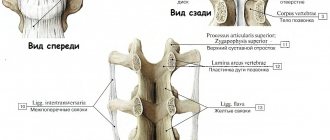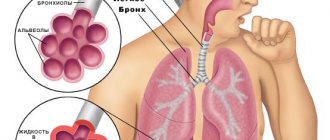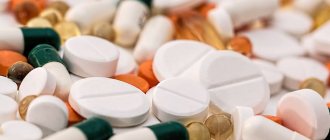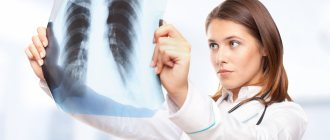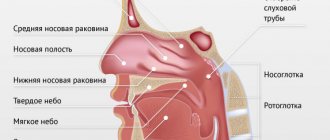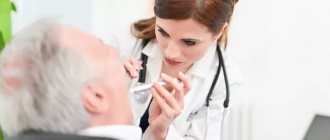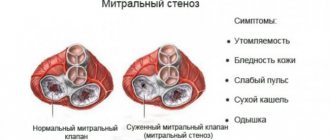COPD - what kind of disease is it? The main cause and development of COPD Stages and degrees of COPD Symptoms and diagnosis Symptoms of COPD in women How COPD differs from bronchial asthma Treatment of COPD Clinical recommendations Treatment of moderate COPD Treatment of severe COPD Non-drug treatment of COPD Drugs Antibiotics for COPD Treatment with folk remedies Inhalers for COPD You can Is it possible to cure COPD completely? Breathing exercises for COPD Diet for COPD Recommendations for patients with COPD
COPD - what kind of disease is it?
According to the National Clinical Guidelines for the Treatment of Patients with Chronic Obstructive Pulmonary Disease and Chronic Heart Failure, COPD is a chronic heterogeneous disease that can be prevented and treated. Heterogeneity means that the disease has heterogeneous manifestations. This is a complex of symptoms of damage to the respiratory system, recorded by medicine as chronic obstructive pulmonary disease. COPD is respiratory symptoms and restriction of air flow into the lungs associated with damage to the airways and/or alveoli. Inflammation destroys the protective mechanisms of the respiratory system, resulting in bronchial fibrosis and, in severe cases, emphysema, cor pulmonale and other serious irreversible diseases.
According to official statistics from the Russian Ministry of Health, the prevalence of serious consequences of COPD among the world's population is 12%. At the same time, more than 50% of the adult population have pulmonary dysfunction and ignore this disease, so the prevalence of COPD is several times higher than the recorded statistics. Currently, there is a significant increase in morbidity and mortality from COPD. Today it has risen from 4th to 3rd place in the list of causes of death in the world.
COPD affects the airways and small bronchi, causing the air flow into the lungs to be significantly reduced. Over time, the elasticity of the lungs decreases, that is, their ability to compress and expand during the inhalation-exhalation respiratory cycle. The lungs lose the ability to fully exhale, a lot of air remains in them, which provokes respiratory failure and disrupts gas exchange.
COPD is characterized by irreversible processes in the bronchi and lungs. The lack of oxygen becomes chronic, carbon dioxide is not excreted within the physiological norm. The mucous membrane loses its protective functions, infectious diseases of the respiratory system become frequent and severe. Most patients with COPD have symptoms of chronic obstructive bronchitis and emphysema.
When not to use O2 therapy
Treatment with oxygen inhalation should not be done if the patient continues to smoke (despite the doctor’s prohibitions) and refuses to take the medications prescribed to him. In most cases, oxygen therapy acts as an adjuvant treatment method. If a person is in serious condition, but ignores medical prescriptions, inhalations alone will not help him become healthy.
Take care of your health. If shortness of breath begins to appear more and more often, be sure to make an appointment with a therapist or pulmonologist. Don't joke about bronchospasm. This is a very insidious condition.
The main cause of the occurrence and development of COPD
Clinical recommendations cite toxic effects on the respiratory system as the main cause. These are smoking, exposure to harmful environmental factors, occupational production risks, silicon and cadmium dust, and environmental pollution. In addition to external toxic effects, the development of COPD can be caused by frequent respiratory tract infections, hereditary factors and a deficiency of the protein α1-antitrypsin (AAT), produced by the liver and released into the blood. Its main function is to protect the lungs from pathological changes in lung tissue.
Stages and degrees of COPD
There are four degrees of severity:
- light,
- average,
- heavy,
- extremely difficult.
Mild COPD often has no clinical manifestations. Sometimes a rare productive cough and mild shortness of breath are possible. Air circulation in the bronchi is intact. These factors do not interfere with a person’s quality of life, and the first stage of COPD usually remains unattended.
With moderate COPD, an obvious cough with viscous sputum appears, especially intense in the morning. Shortness of breath is noticeable during physical activity. During periods of exacerbation, sputum with pus is separated, and shortness of breath appears at rest. In the bronchitis type of COPD, during the period of exacerbation, wheezing is heard, and the neck muscles and intercostal muscles take part in breathing.
The severe stage of COPD is a cough with sputum production and constant wheezing. Shortness of breath is constant even with little effort. Exacerbations occur more often than once a month. Breathing is noisy and heavy, muscles are actively involved in it, a barrel-shaped chest is formed, blood vessels protrude on the neck, and weight loss is observed. With bronchitis type COPD, bluishness of the skin and swelling are noticeable.
The fourth degree of COPD is respiratory failure, persistent cough and wheezing, shortness of breath. Physical effort becomes minimal, breathing is carried out only with muscle effort. Cor pulmonale is formed, a serious complication that leads to heart failure. The patient becomes disabled and undergoes constant oxygen therapy, since the body cannot independently provide oxygen in the fourth stage of COPD.
How to understand that inhalation therapy is indicated
The following symptoms indicate that the patient cannot do without oxygen therapy sessions:
- cough with phlegm;
- shortness of breath (can be felt even during rest);
- nausea;
- increasing weakness;
- acquisition of a bluish tint to the skin;
- exhaustion.
If a bacterial infection has occurred, impurities of pus may be visible in the sputum. This is a very bad symptom.
Symptoms and diagnosis
Early signs of COPD are cough and sputum production. These manifestations go from episodic to daily. Several years after the onset of the disease, shortness of breath appears, which progresses. More pronounced symptoms are weakened, wheezing breathing, shortened exhalation, breathing through clenched teeth, formation of a barrel-shaped chest, weight loss. With increasing respiratory failure, a bluish tint of the skin, swelling and puffiness of the face are formed.
Early diagnosis of COPD is not very possible; the disease can only be recognized when symptoms appear, which can be identified using diagnostic methods:
- radiography,
- computed tomography of the chest,
- spirometry,
- laboratory tests of sputum microflora,
- determining the level of alpha-1-antitrypsin,
- ECG and ECHO to detect heart complications.
Types of disease
Oxygen therapy for COPD helps regardless of the stage of the disease. There are four of them in total:
- Zero. Pre-illness state. A person has a tendency to develop lung disease. But this does not mean that obstruction will necessarily develop. Upon examination, the doctor notes a persistent cough and copious sputum production. The functions of the paired organ remain unchanged.
- First or light flow. Insignificant obstructive changes are detected. The cough becomes chronic. Sputum is intensely separated, but is poorly expectorated.
- Second or moderate course. Forced expiratory volume (FEV) ranges from 50 to 80% of normal values. The patient complains of difficulty breathing, shortness of breath.
- Third or severe course. FEV ranges from 30 to 50%. Shortness of breath becomes more pronounced. From time to time a person has the feeling that he is about to die from suffocation.
- Fourth or extremely severe course. Obstruction of the pulmonary tissues is pronounced, respiratory failure is observed. Pulmonary heart syndrome develops.
To prevent the pathology from progressing, it is important to treat it in the early stages. With the help of oxygen therapy, you can quickly achieve sustainable positive dynamics.
How does COPD differ from bronchial asthma?
The symptoms of the diseases are similar, but, nevertheless, there are obvious differences that make it possible to make an accurate diagnosis and prescribe the correct treatment. COPD rarely has a direct allergic origin. Asthma is often associated with allergies. COPD is most often a disease of older people who smoke. The prognosis for treatment of this disease is determined by a special formula: the number of cigarettes that the patient smoked during the day is multiplied by the duration of smoking in years. And the higher the result, the worse the prognosis.
Asthma occurs even in young children. In addition, asthma is a paroxysmal cough that appears after contact with substances that cause an allergic reaction. In COPD, symptoms progress over several years.
Asthma is accompanied by conjunctivitis, atopic eczema, and COPD is complicated by diseases of the cardiovascular system.
Treatment of COPD
Patients with COPD must take treatment regularly. In the acute stage, it is more intense, with the use of antibacterial therapy and, if necessary, oxygen support.
COPD is treated with medications and non-drug methods, the latter including a set of measures to change lifestyle and support the general resources of the body.
Clinical guidelines
National clinical guidelines for the treatment of patients with chronic obstructive pulmonary disease and chronic heart failure were adopted at the XIII National Congress of Physicians in November 2021. They were created to familiarize primary care physicians with modern data on the management of patients with chronic obstructive pulmonary disease and chronic heart failure, the formation of diagnostic approaches, early diagnosis algorithms, principles of drug therapy and drug-drug interactions. Clinical recommendations are aimed at stopping the development of the disease and blocking its progression to severe complications in the form of incurable heart disease.
Treatment of moderate COPD
Moderate severity of COPD allows for therapy that reduces the rate of progression of the disease while completely limiting exposure to harmful factors, including immediate and complete cessation of smoking. Bronchodilators slow down bronchial obstruction. During exacerbations, inhaled glucocorticoids are widely used in therapy. They can be used in conjunction with adrenergic agonists. Long-term use of glucocorticoids in tablets is not recommended, as they have many side effects.
Treatment of severe COPD
At this stage of the disease, previously administered therapy is intensified. Doses of inhaled glucocorticosteroids are prescribed using the drugs beclazone, benacort, pulmicort, becotide. All of them are included in therapy using a nebulizer. Treatment includes combination drugs (bronchodilators and inhalation corticosteroids), such as Seretide and Symbicort. During the period of exacerbation of the disease, urgent hospitalization and intensive care in a hospital are often required.
Non-drug treatment of COPD
Non-pharmacological treatment consists mainly of pulmonary rehabilitation measures. According to the definition of the European Respiratory Society, it is a process that systematically uses evidence-based diagnostic and therapeutic methods aimed at achieving the optimal functional state and quality of life of a patient suffering from chronic lung disease. Rehabilitation measures include physical therapy and breathing exercises, changing lifestyle and daily living conditions, reducing stress factors and increased fatigue, and proper nutrition. In addition, oxygen therapy (according to the doctor’s indications) has a good effect in alleviating the patient’s condition.
Drugs
Depending on the degree of development of the disease, therapy includes bronchodilators of two pharmacological groups - beta-agonists and M-anticholinergics. They affect bronchial patency and relax the airways. Anti-inflammatory therapy with inhaled steroids is actively used. They cause a decrease in the inflammatory response in the bronchial tree, which inevitably develops in patients with COPD.
Antibiotics for COPD
In many cases, COPD is bacterial in nature, and in this regard, antibacterial therapy is relevant.
Antibiotics are prescribed for exacerbations, in particular, increased shortness of breath, purulent sputum, and severe cough. Depending on the bacterial causative agent of COPD, drugs are prescribed: levofloquacin, amoxiclav, azithromycin are effective for Haemophilus influenzae; moxifloxacin - for pneumococcus.
In order for treatment to bring maximum results, it is necessary to conduct a sputum analysis to determine the bacterial pathogen and strictly follow the doctor’s instructions.
Treatment with folk remedies
Folk remedies for COPD do not attract widespread approval from doctors, but the experience of generations often inclines patients towards remedies that have been proven for centuries to alleviate the condition. First of all, folk remedies for COPD are used to thin sputum and facilitate its passage from the bronchi.
Since ancient times, anise seeds have been very popular in the treatment of pulmonary diseases. Its essential oil has a strong anti-inflammatory, mucolytic and antispasmodic effect. The most famous and simple recipe for a cure for COPD is brewing anise seeds. 1 teaspoon of seeds is poured into a thermos with a glass of boiling water. Leave for 15 minutes, cool in a jar and drink 50 g 4 times a day, half an hour before meals.
Another favorite folk treatment for COPD is pansies. This type of violet contains flavonoids, anthocyanins and glycosides and helps with expectoration. The medicine is prepared and consumed in the same way as anise seed tincture.
Thyme or thyme is a medicinal plant that is used for a number of diseases. A remedy that relieves the symptoms of COPD is prepared as follows. 4 tablespoons of herbs are poured into a liter of very hot water (not boiling water). Leave for an hour and drink 1 tablespoon 3 times a day before meals. The decoction should be stored in the refrigerator. The course of treatment is 1 month, after which a two-week break is taken and the decoction is repeated.
Inhalers for COPD
The advantage of inhalers is that they allow medications to be delivered directly to the site of the disease. Inhalers include nebulizers, aerolyzers, metered-dose aerosol inhalers, etc.
Universal compressor inhaler - nebulizer. It is the one most often used in home therapy; it is enough to simply buy pharmacological agents for inhalation. It is important to remember that when prescribing a drug containing an inhaled corticosteroid, you need to know special rules for inhalation. If this procedure is carried out incorrectly, the therapeutic effect of the drug is reduced and there may be side effects.
A metered dose aerosol inhaler, colloquially called a “pshikalka”, is also quite popular. Its use is associated with dosing the drug by independent effort and controlling inhalation when pressing a button. However, for many, this option of inhalation is more familiar and accessible.
Many still remain fans of conventional steam inhalations using hot steam and independently prepare a mixture of herbs, over which they breathe for 10 minutes.
Breathing exercises for COPD
Breathing practices are one of the ways to treat the disease. During training, the respiratory muscles are strengthened, which reduces the unpleasant consequences of bronchial obstruction.
Breathing exercises for COPD can slow down the rate of development of the disease and stop its transition to severe stages, eliminate respiratory failure, improve the flow of air into the lungs, reduce attacks of suffocation, and increase tissue elasticity. In addition, breathing exercises improve the body’s overall immunity, making it stronger and more confident in the fight against infectious diseases.
The advantages of training with the Samozdrav breathing simulator for COPD are that most of the positive effects of conventional breathing exercises are enhanced by breathing a hypercapnic mixture. These exercises quickly restore the body's gas exchange, normalize the functioning of the respiratory system and significantly alleviate the symptoms of COPD. In the early stages of the disease, training with Samozdrav will be a significant contribution to complete recovery from this disease.
“Samozdrav” is indispensable for chronic obstructive pulmonary disease. It can be the most effective help for such patients for whom physical exercises of ordinary breathing exercises are not always comfortable. The simulator allows you to be at rest, at the same time it is an excellent simulator of physical exercises, quickly restores gas exchange, and makes the respiratory cycle normal. Regular exercise will help people with COPD live a full life, gradually and confidently restoring respiratory function, working on the problem and defeating the disease.
2. Drug treatment of the disease
To treat COPD, medications are also used that can perform different functions. Yes, bronchodilators
help open the bronchi, which in turn makes breathing easier. These medications may be short-acting (to quickly relieve symptoms of the disease) or long-acting to help prevent them.
Anti-inflammatory drugs
to treat COPD symptoms (such as corticosteroids) may come in the form of tablets or inhalers that help the medicine go directly to the lungs.
Visit our Pulmonology page
Recommendations for patients with COPD
The first recommendation for patients with COPD is to quit smoking, including passive smoking. It is important to avoid irritation and learn how to properly respond to stress, eliminate exposure to any environmental factors, including air pollution, dust and allergens.
Exercise is recommended for patients with COPD. Their absence can weaken a person's muscles, heart and lungs. Exercise is important to keep the body strong.
According to the recommendations of medical communities, the duration of training, depending on the patient’s condition, is set from 10 to 45 minutes, the frequency of training is up to 5 times a week, and the intensity is from 50% of peak oxygen consumption to the maximum tolerated load, determined by the patient’s subjective sensations.
